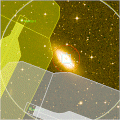
| You are in: Observing Tool (OT) > FAQ |
 |
Observing Tool FAQ |
Frequently asked questions regarding Phase II science program preparation and the Gemini Observing Tool are discussed here. (See also the known bugs page for other known problems).
All questions should be submitted using the Gemini HelpDesk. This web-based system will send the request to your National Gemini Office staff in the first instance who will then provide you with the answer or escalate it to Gemini staff if necessary.
 Please read the special instructions regarding completion of your Phase
II Science Program including those specific to the current/upcoming semester and
where to go for help. Follow the link in the contents list for details.
Please read the special instructions regarding completion of your Phase
II Science Program including those specific to the current/upcoming semester and
where to go for help. Follow the link in the contents list for details.
Q: Are there any example observations to help me get started with my Phase II?
A: Yes, there is an OT library for each instrument that you can fetch. Each contains example observations and common configurations. Starting with the 2008A OT there are special Library Fetch features for quickly fetching and updating the needed libraries.
Q: Why did the changes that I made to my program disappear after I stored the program?
A: The OT has a complicated set of rules governing fetch/store privileges and synching the local and observing databases. PIs have the privilege to overwrite observations with status "Phase 2" and "For Review." The database prevents the PI from changing observations with other statuses and will update the PIs local database with the information in the observing database if there are discrepancies. Since the status of observations in the observing database can change at any time, PIs should always fetch their program before editing it and save changes to XML before storing.
Q: Why is the OT so slow?
A: The OT runs quickly on modern hardware with sufficient memory. A Pentium III or equivalent with at 512 MB of memory is the recommended minimum configuration. However, since the OT has a complicated GUI it does not work well if it is run on a remote machine and displayed locally. It is usually best to run the OT on the local machine.
Last update June 7, 2008; Bryan Miller